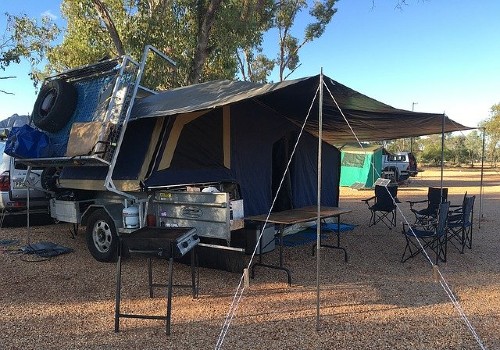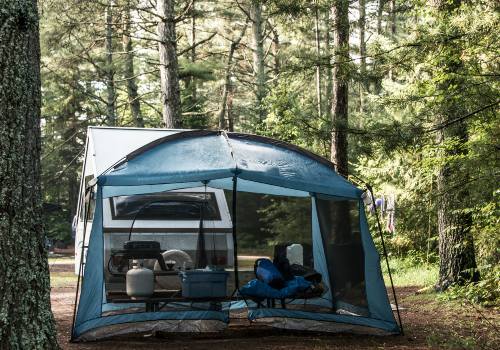Expandable campers have made the RV lifestyle accessible without breaking the bank. Part-time campers have found this category of RV budget-friendly, family-friendly, and easy for first-timers to begin their adventures. As people begin to plan, they’ve wondered, how much do pop up campers weigh and what other considerations do they need to know?
We’ve put together some perspective building facts and examples to help you understand the pop-up category. We’ll show you the basic terminology that comes with towing. We’ll also show you some tow vehicle examples and how to calculate a realistic idea of everything that goes into total weight capacity.
Finally, we’ve collected a list of excellent examples that demonstrates the variety of options you can choose from in the expandable category. We’ll explain the advantages to each and some issues worth considering.
General RV Weight Terminology
- Unloaded Vehicle Weight (UVW): This measurement is the empty weight of the RV. It’s also referred to as the dry weight.
- Curb Weight: This is the dry weight plus the weight of the filled water tanks, propane, and house batteries. Known as the wet weight, at this level, the RV is ready to camp.
- Cargo Carrying Capacity (CCC): This is the maximum amount of weight the RV can carry throughout the entire coach.
- Gross Axle Weight Rating (GAWR): The GAWR is the most weight that can be carried on the axles.
- Gross Tongue Weight (GTW): The tongue weight is the pressure the RV puts on the tow vehicle’s hitch. A good rule of thumb is to keep the hitch weight around 10% of the RV’s Gross Vehicle Weight.
- Gross Vehicle Weight Rating (GVWR): This is the total weight amount the RV manufacturer recommends not to exceed for safety purposes. To find your actual Gross Vehicle Weight (GVW), there are websites and apps you can use to find vehicle scales in your area.
Best Vehicles

The average weight of pop-up ranges from 840 to over 4,000 pounds. Most small and mid-size SUVs and crossovers are the preferred vehicles for towing. Full-size sedans that can tow generally have a maximum capacity of 1,750 pounds when properly equipped.
When you factor in the curb weight, camping gear, personal items, and people traveling with you on the trip, it’s easy to exceed the GVWR of the full-size sedan’s limit. If you do stay under the maximum capacity, you still want to save some of that horsepower and torque to maintain driving speed and handle road conditions like inclines.
The ideal towing capacity should be about 1,500 to 2,500 above the RV’s dry weight. This will give you plenty of weight for packed items, passengers, and driving power.
For example, the Ford Explorer has a maximum towing capacity of 5,600 pounds. Ideally, you would want at least 500 pounds for driving power. If two people are going on the camping trip, assume 200 pounds for each person, even if each one weighs less than that (keeping the math simple).
Your camping gear, clothing, food, and other personal items we’ll assume another 500 pounds to be conservative. Between driving power, people, and gear (500 + 400+ 500), that’s 1,400 pounds before the RV.
This leaves 4,200 pounds available for towing, but you never want to push your tow vehicle to its limit. Your vehicle doesn’t like stress like our own bodies. Exposing it to high levels of stress for long periods of time can lead to various parts breaking down sooner.
A pop-up that would fit well for this example would be the Forest River Rockwood Tent High Wall HW277. This soft-side pop-up has a dry weight of 3,334 pounds and stretches 25.9 feet when opened up.
The rear bed measures to a queen, and the front is a king. It has a U-shaped dinette on a slideout that also converts for guest sleeping. Rockwood installed a wet bath with a commode and shower. It has both an inside and outdoor kitchen to take full advantage of the camping experience.
Here are some other example tow vehicles to consider. Some of these minivans, SUVs, and crossovers have options to increase towing capacity. Your owner’s manual gives you the specifics on what your vehicle’s actual towing capacity is and what it’s equipped with.
- Mazda CX-7 2,000 pounds
- Infiniti QX50 3,000 pounds
- Subaru Outback 3,500 pounds
- Dodge Caravan 3,600 pounds
- GMC Acadia 4,000 pounds
- Jeep Gladiator 4,500 pounds
- Toyota Highlander 5,000 pounds
- Ford Explorer 5,600 pounds
Soft-Side Pop Up and Examples

Pop up camper weight limits average are as light as 840 pounds and are as heavy as 3,400 pounds. They have been around since the 1970s and have evolved to become great family campers for those that enjoy weekend getaways.
Lightweight pop up campers have full kitchen amenities, furnaces, a lot of storage, are sedan-friendly under certain conditions. You’ll find those pop-up campers under 1,500 lbs., are more basic compared to their heavier counterparts but have the same quality construction.
Some great examples are:
- Ultra lightweight: Sylvansport GO, 840 pounds UVW
- Classic Floorplan and Lightweight: Coachmen Clipper LS 806XLS, 1,642 UVW
- Best Off-Road and Quickest Setup: Opus Camper OP4, 2,870 UVW
- Most Features with a Slideout: Aliner Somerset E3 Deck, 2,908 UVW
Hard Side Pop-Ups and Examples

Hard side pop-ups are not new. People that have wanted an expandable camper that’s well-insulated have fueled the popularity of these units. Cabled pulley systems, hydraulic lifts, and various other devices have created unique expandables like the once-popular Hi-Lo.
Hard side pop-ups, mostly A-frame campers, don’t have the space soft sides have, but new technology is quickly compensating for that. Bigger A-frames now have dormer roof expansions that give more headspace than standard triangular roofs.
Features and amenities inside rival soft sides and some small travel trailers. You’ll find beds that range from full to king size. Dinettes, sofas, and deep cabinet storage. Kitchens have everything you can expect: hot/cold sinks, built-in propane stoves, microwaves, and refrigerators. Many even have furnaces and air conditioners.
The average weight of these pop-ups ranges from 1,000 pounds to 3,200 pounds. The examples below will show you how evolved the hard-side expandable category has become.
- A Great A-Frame With a Dormer: Aliner Ranger 10, 1,225 UVW
- A Popular Off-Road Model That’s Highly Versitile: Chalet Classic Arrowhead, 1,585 UVW
- Best Two Twin Floorplan With the Best Features: Forest River Flagstaff Hardside High Wall T21TBHW, 2,670 UVW
- A New Fold Out Expandable With a King Size Bed: Trailmanor 2922, 3,130, UVW
How Much Weight Can a Pop-Up Camper Frame Hold
Pop-up campers have a lot of storage both inside and out. Many come with front storage trunks built on to the frame and/or chassis. Some of our readers have asked if expandable RVs support roof racks for small boats, roof cargo containers, or other items.
The weight you add to a camper safely should be between 500 to 1,800 pounds. Your individual owner’s manual will tell you the specific Cargo Carrying Capacity (CCC). This includes everything you pack in the cabinetry and external storage bays.
Most campers use aluminum framing and other strong materials on the roof. When it’s closed up, that’s when your RV is the strongest. The chassis is made out of steel tubing like all other coaches in the RV world.
Some pop-up campers have rear hitch receivers that allow you to connect additional storage features. Doing this puts the weight on the chassis instead of the frame of the coach.
A popular option is connecting a bike rack to the receiver. Another option is a rear cargo carrier tray. Many of these trays give you extra space and can hold up to 600 pounds. You’ll need to find out what your camper’s chassis can actually hold so you don’t go overweight.




